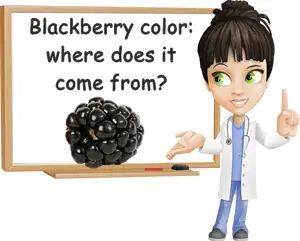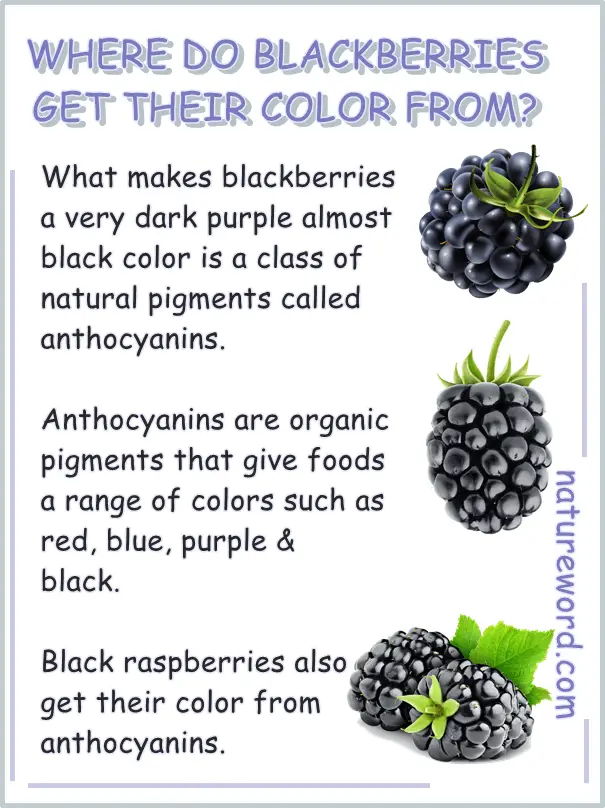Do you know where blackberries get their color from? Why are blackberries such a dark color? Are blackberries GMO? Is blackberry color natural? What is the difference between the color of blackberries and black raspberries? Do blackberries come in other colors too like raspberries that are red, yellow and purple?
What are blackberries?
Blackberries qualify as culinary berries. Other culinary berries include blueberries, blue honeysuckle berries, raspberries, strawberries, currants, cranberries, goji berries and elderberries.
But botanically speaking, blackberries are not real berries – they are in fact aggregate fruit, that is, multiple botanical fruit born from a single flower and merged into one. Raspberries and strawberries are not real berries either, but bananas and watermelon are.

What color are blackberries?
Despite their name, blackberries are not actually black, but purple. A blackberry is a very dark purple color, but because of the intensity of its pigment it appears black. Some say blackberries were named after their very dark color which is not an uncommon practice. In fact, there are voices that feel blackberries shouldn’t be considered as having a purple color, but rather black because that is their perceived color.
Are blackberries GMO or natural?
Were blackberries born the way they are or were they made to look like they do? With the overwhelming variety of food that exists, it’s sometimes difficult to tell with certainty if a food is natural, as in it came to be the way it is naturally, or GMO, as in genetically modified to look and taste the way it does. With blackberries it’s simpler: historic texts document the consumption of blackberries some 2500 years ago.
In the beginning blackberries were sourced exclusively from the wild where they occurred naturally and were either consumed as fresh fruit for their vitamin C which helped with teeth and gums health (although this wasn’t known that long ago), or used to make fermented alcoholic beverages such as wines.
Between that far along in history and now, blackberries have remained available as a forage fruit, also called forest berries, and have also been picked up for cultivation. Plant breeding efforts have helped develop at least a few hundred cultivars with more desirable characteristics. Although modern cultivated blackberries are, to a certain extent, not that much different from the original berries occurring naturally in the wild, as in they preserve the bulk of the fruit’s characteristics, modern cultivars are definitely improved.
Characteristics that have been developed anew in blackberries include: increased resilience to certain diseases that commonly affect the species, or reduced susceptibility to them, the absence of thorns, more fruit per plant, larger fruit that are also firmer which improves shelf like and favors distribution as fresh fruit over greater distances, and better flavor.

Where do blackberries get their color from?
What makes ripe blackberries a very dark purple color that appears black is a class of natural pigments called anthocyanins. Anthocyanins are organic pigments that double as antioxidants. Different anthocyanins give different colors in foods, including red, purple, blue and black.
The fact that blackberries have such a dark color is indication both of a particular anthocyanin profile and of a very high anthocyanin content. In fact, you can use blackberry juice as a natural dye to color cake batter, frosting, ice cream, smoothies, and it’ll even stain clothes.
Anthocyanins are responsible for the color of ripe blackberries, blueberries, purple plums, dark red cherry plums, dark colored grapes, blue tomatoes and black tomatoes, eggplants, black bell peppers, purple and black raspberries as well as red and black mulberries.
Why are blackberries the color they are?
Blackberries start out a pale green color when unripe. As they start to ripen, they begin to change color and turn a pale orangey-red then a deeper wine red color and finally a very dark purple – black. The transition from pale green when unripe to almost black when ripe is genetically determined.
That is, blackberries have it in their DNA to develop their particular color when ripe. While the pigment is surprisingly dark, the color of the berries is completely natural. Similarly, the color of purple raspberries, while unusual, is also natural. Also find out why purple raspberries are purple.
Blackberry vs black raspberry color: is it the same thing?
Yes and no. Blackberries and black raspberries both get their color from the same class of natural pigments: dark colored anthocyanins. However, they don’t have the exact same anthocyanin profile, and definitely don’t have the exact same amounts of all anthocyanin constituents.
See more differences between blackberries and black raspberries.
Red raspberries also owe their color to the same class of anthocyanin pigments present in blackberries, and so do purple raspberries and blueberries and blue honeysuckle berries and more colorful fruit. Yet the end result is always a little bit different due to each fruit having more of less of certain anthocyanin pigments which ultimately determines its exact color when ripe.
